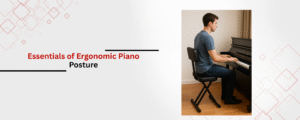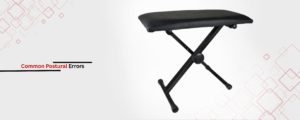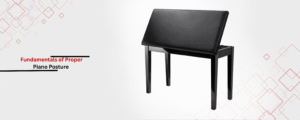Correct posture at the piano bench is important when considering stamina and injury prevention. Correct placement of the stool or the seat along with the torso, head, arms, and legs requires attention. A subtly misplaced bench can also lead to fatigue bordering on repetitive strain injuries; control over forte and piano is lost. This guide attempts to outline optimal ergonomic principles, paying special attention to the seat, and tips that will prompt change in sitting posture to enhance performance.
To know more, read: From Wooden Stools to Adjustable Benches: The Journey of Keyboard Seating
Essentials of Ergonomic Piano Posture
Bench Alignment:
Back posture is upright and neutral, which results in the lower back side of the body being kept straight, i.e., no slouching allowed. Shoulders and neck must be relaxed without the need to arch the lower back. An appropriate posture when sitting at the keyboard level requires the alignment of the seat height to be raised so that the forearm rests parallel to the ground and the level of the elbows is at the keyboard level.
Feet and Legs Positioning:
To provide additional support to the body, the legs are positioned shoulder-width apart. Use of a footrest or an adjustable platform may be required in the case of shorter pianists to assist in alignment. The level of the knees makes sure that there is no overexertion of the legs while the body accesses the pedals.
Hand and Wrist Relaxation:
Let the arms extend naturally from the torso and keep the shoulders relaxed to assume a neutral position. Hands and wrists ought to be positioned hovering over the keyboard at its height to eliminate any rise or droop that would put strain on the hands. The fingers are to be flexed for ease and balance, like encapsulating a small sphere, to enable a proper grasp for maximum agility during action.
Common Postural Errors and Their Impacts
Bending Forward or Slouching:
When shifting weight towards the hands and leaning the upper body forward, the head shifts to go in front of the body, which positions the palms and weight on the hands for finger movement; fingers are unable to move independently and are set to a fixed position. Due to this shift in posture, most people develop some restriction in movement of the back, which is commonly referred to as back tensile pain. It doesn’t stop there; over time, this could develop into chronic pain or worse, shocking discomfort if nothing is done.
Incorrect Distance or Height of the Piano Bench:
If the distance from the keyboard is greater than what is comfortable (far enough to require stretching), the piano bench turns too low, causing an unnatural hand position facing down. Alternatively, in cases when the bench is located too high, rotational strain sets in about the shoulder. The position of the keyboard on the workstation also needs monitoring because its distance affects arm movement and pedal interaction, which in turn impacts flexion and extension of the arms, thereby signifying bench height relevance.
Tightness in the Hands and Wrists:
Tightness in the fingers and wrists can significantly constrict motion in terms of freedom and speed. Shaking hands and turning wrists are suggested as warm-up exercises during practice.
Practical Approaches to Maintain Posture
Regular Movement and Breaks:
Posture micro-breaks aimed at the back, shoulders, and wrists are incorporated every 20–30 minutes. Simple yogic postures or shoulder rolls aid in the elimination of tension while rebalancing the body.
Corrective Play for Posture Around The Piano
Self-correcting towards the relevant posture is achievable easily with a mirror placed beside the piano. Deliberate slow playing should be the aim for proper piano posture to enhance movement control throughout the entire music performance.
Ergonomic Accessories:
Anti-slip mats, lumbar support cushions, and a variety of adjustable piano benches are offered for the alteration of chair positioning to suit specific preferences. These aids assist in meeting the differing ergonomic needs of users.
Conclusion
As noted earlier, proper playing habits need to incorporate correct alignment and positional shift, which are a result of the correct height of the piano bench. It is the positioning of the piano bench that provides comfort and further encourages effective technique. Ergonomic design of seating has also been greatly aided by brands like 5 Core, Roland, On Stage, and Donner. These principles will always be true so long as design technology continues to progress, something we can never predict about the future. On the other hand, one thing that is certain is proper alignment will always exist at the center of musical excellence.




